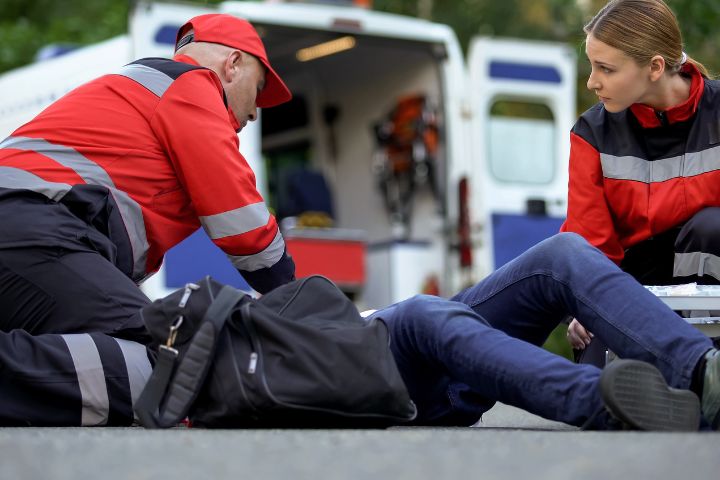If you’ve ever wondered what it takes to be the first on the scene in a medical emergency, EMS training programs might be your perfect next step. Whether you’re looking to become an EMT, a paramedic, or an emergency medical responder, this rewarding career path is all about making a difference in your community—and it starts with the right training.
If you’re interested in this rewarding career path, this blog post is here to break down everything you need to know about emergency medical services programs, EMT certification, and the journey to becoming a paramedic. Let’s dive in!
Explore Dorsey College’s EMS programs
The different EMS career opportunities
When you think about emergency medical services (EMS), you might picture an ambulance racing to the scene with lights flashing. But EMS is more than just fast driving and quick thinking—it’s a structured field with several career paths that vary in responsibility, training, and scope of practice.
Here are the main EMS career opportunities:
Emergency Medical Responder (EMR)
An EMR is often the first responder to a medical emergency. These professionals provide basic, immediate care such as CPR, bleeding control, and patient assessment while waiting for EMTs or paramedics to arrive. Emergency medical responder programs typically require less training than other EMS roles but can still offer a vital entry point into the field.
Emergency Medical Technician (EMT)
EMTs are trained to handle a wider range of emergencies. They can provide basic life support (BLS), use certain medical equipment, and transport patients to healthcare facilities. EMTs work on ambulances, in hospitals, and even in fire departments.
Paramedic
Paramedics are the most advanced level of EMS providers. They can perform advanced life support (ALS) procedures such as intubation, EKG monitoring, medication administration, and more. Paramedic training is more in-depth and typically follows EMT certification.
Each role plays an essential part in the chain of emergency medical care—and your journey starts with choosing the EMS training program that matches your goals.
Exploring EMS Training Programs
There’s no one-size-fits-all path in EMS. Emergency medical responder programs, EMT courses, and paramedic programs are designed with different skill levels and outcomes in mind.
Emergency medical responder programs are ideal for individuals who want to begin a career in emergency services quickly. These programs cover:
- Basic patient care techniques
- CPR and AED use
- Trauma and medical emergency response
- Patient assessment
EMR programs can be completed in a relatively short time, making them a great starting point or supplemental training for other professionals like police officers or firefighters. However, if you want to fully immerse yourself in an emergency healthcare career, EMT or paramedic training is the way to go.
EMT training programs go deeper than EMR and typically take several months to complete. At Dorsey College, our EMT training includes classroom instruction, hands-on skills labs, and clinical experiences designed to prepare you for real-world emergencies. Topics covered include:
- Airway management
- Basic pharmacology
- Medical and trauma emergencies
- Patient transport and documentation
Upon completion, graduates are eligible to take the National Registry of Emergency Medical Technicians (NREMT) certification exam to become licensed EMTs.
If you’re serious about advancing in EMS, a paramedic program is the way to go. These programs build on EMT knowledge and teach more complex procedures. Expect coursework in:
- Advanced airway techniques
- Cardiac life support
- Medication administration
- Pediatric and obstetric care
- Scene leadership and decision-making
Paramedic programs usually take 12-24 months to complete and require a strong commitment—but the payoff can be worth it.
What Can You Expect During Training?
EMT and paramedic training programs are fast-paced, hands-on, and immersive. You’re not just sitting in a classroom—you’re preparing for real-life situations where split-second decisions can save lives. Here’s what to expect during your EMS training program:
- Classroom Instruction: You’ll cover essential anatomy, physiology, medical terminology, and emergency procedures. This foundation can give you the knowledge to make informed decisions in the field.
- Skills Labs: Get ready to roll up your sleeves. Skills labs are where you’ll practice life-saving techniques on mannequins and simulation equipment. You can learn how to control bleeding, insert airways, splint injuries, and more.
- Clinical and Field Experience: Most emergency medical technician training programs include clinical rotations or ride-alongs with EMS crews. This is your chance to apply your skills in real-world situations and learn from experienced professionals.
- Certification Preparation: To work in EMS in the U.S., you will need certain certifications. At Dorsey College, our training programs are designed to prepare you for the national certification exam so you can pursue your State of Michigan EMT or paramedic license*. If you’re ready to pursue these career paths, we’re here to help!
Is pursuing a EMS career for you?
EMS work isn’t for everyone—but for the right person, it’s one of the most rewarding careers out there. Here are a few questions to ask yourself:
- Do you stay calm in high-pressure situations?
- Are you a quick thinker with strong problem-solving skills?
- Do you enjoy helping others and making a difference?
- Are you ready for a physically and emotionally demanding role?
If you answered yes, then EMS might be the perfect fit for you.
Keep in mind, EMS careers often involve irregular hours, night shifts, and challenging environments. But the impact you make—saving lives, comforting families, supporting your community—makes every second worth it.
Emergency medical responder programs, EMT training, and paramedic programs open doors to an exciting and vital career. If you’re ready, here’s how to get started on this rewarding career path:
- Research different programs to find the right fit for you. At Dorsey College, we offer EMS training programs for EMTs and paramedics, designed with your success in mind.
- Research what certifications are necessary for working in EMS in your area.
- Apply for programs.
- Complete curriculum and hands-on training.
- Pass any required certification exams and gain your license through the state.
- Start applying for jobs!
Whether you’re starting fresh or looking to expand your skills, Dorsey College is here to help you take that next step. We combine experienced instructors, real-world practice, and exam preparation to get you ready for the field. Plus, with campuses conveniently located in Michigan, starting your journey has never been easier.
If you’re ready to make a difference in people’s lives and join the fast-paced world of emergency medical services, don’t wait. Explore our EMS training programs and take the first step toward a rewarding future.
* Dorsey College has determined that its Emergency Medical Technician training program and Paramedic training program curriculums are sufficient to fulfill the respective educational requirements for licensure in the State of Michigan only. No educational determinations have been made for any other state, district, or US territory in regards to licensure requirements.
1. https://www.bls.gov/ooh/healthcare/emts-and-paramedics.htm

